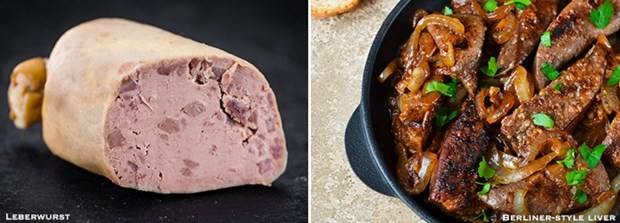Science helps us to understand what liver is, and how to cook this offal to appreciate it the best. Don't miss the tips!
In
the succulent and variegated world of offal, liver is the unquestioned
protagonist. It owes this popularity to its particular composition.
Anatomically speaking, liver is a gland, which serves multiple functions, the
main ones being the storage of glycogen, protein synthesis and the production
of bile. Hence its typical flavour, a delicate mix of sweet, bitter and acidic
tastes which lend themselves to being enhanced in an endless number of recipes.
Strictly speaking, it is possible to consume the liver of all those animals
which normally provide us with nourishment, fish included, but the ones we are
most familiar with come from pigs and calves since they are cheap, widely
available and easy to cook.
The chemical
composition of liver
While
differing from one species to another, the consistency of liver is always quite
similar, this being something a skilled cook has to bear in mind. In
particular, it is rich in glutathione and thiols. The former is a tripeptide
made up of the amino acids cysteine, glycine and glutamate (which is the salt
of glutamic acid) and is partly responsible for the “metallic” taste of liver.
The latter are alcohols to which we owe the characteristic smell of this gland.
During the cooking process, the two compounds have no small impact on the taste
and aroma of this dish. To mitigate this somewhat aggressive flavour, it is a
good idea to leave raw liver to marinate in an acidic substance, such as lemon
or lime juice, or even vinegar. This will actually limit the oxidation of
glutathione and thiols during the subsequent cooking process.
How to cook liver

Venetian style liver.
There
is no perfect way of cooking liver. To avoid errors and give your creativity
free rein, you need to bear a few simple rules in mind. The first one has to do
with consistency. Raw liver is gelatinous owing to the considerable amount of
water it contains (about 70%) trapped by a dense network of proteins (20%) and
fat molecules (4-5%). This means that it must be cooked rapidly at a high
temperature. “Stewing” liver or subjecting it to a long slow cooking process
leads to its dehydration, which makes the fibres tough and the resulting dish
dry and difficult to chew. The more daring foodies like to eat very fresh
calf’s liver served raw, cut into thin slices and dressed with oil and salt,
but it is not necessary to go that far to enjoy this particular type of offal
at its best.
Venetian liver
Take
Venetian-style liver for instance. In the eating houses of the celebrated
lagoon city, the recipe differs from the one to be found in cookery books, and
the basic rule is that the liver must be barely “seared”. Take half a kilo of
pig’s liver (but nowadays calf’s liver is used to the same extent) and cut it
up into strips. In the meantime, fry two sliced white onions in 50 grams of
butter over a very gentle heat. When half cooked, add three spoonfuls of white
vinegar and one spoonful of water. Then increase the heat and add the liver,
cooking it for no more than five minutes, before seasoning with salt and a
generous dose of black pepper. Most important: the liver hasto be consumed
immediately and never, never reheated. Rather than this, it would be better to
eat it cold.
Milanese-style liver
Piping
hot, on the other hand, is the ideal temperature for Milanese-style liver,
which is a sort of variation on the traditional breaded cutlet theme. The calf
liver slices are used whole. They must be dried and then dipped first in beaten
eggs and then in breadcrumbs, pressing the crumbs down to make them adhere
well. Finally, the liver slices are fried in plenty of groundnut oil but only
for a few minutes, as in the previous recipe. Season with salt when cooked.

Leberwurst | Berliner style liver
Berliner style liver
Time
is precious also when preparing liver, the Berliner way. First of all, peel
four red apples and remove the core, before cutting them into slices about one-centimetre-thick
and sprinkling them with lemon juice. Then take the slices of calf liver, add
salt and pepper, dip them in flour and fry in a little butter for a couple of
minutes on both sides. Heat some more butter in a saucepan and gently fry two
large sliced onions to which you will also add the apples and, when these are
cooked, a couple of spoonfuls of vinegar. The liver is then served with the
onion and apple compote.
Leberwurst
Leberwurst, on the other hand, is a type of
sausage made from pig’s liver. It is not simple to make at home and it calls
for very fresh cuts of meat. Practically, you take the pig’s offal comprising
liver, bile ducts and gallbladder and blanch it in boiling salted water. When
cold, it then hasto be minced with one third of its weight in raw liver,
together with various spices and herbs. Finally, the mixture is piped into a
sausage casing and used fresh for spreading on bread. Try these recipes and you
will realize what wonderful flavours a humble piece of liver can offer.
By FDL